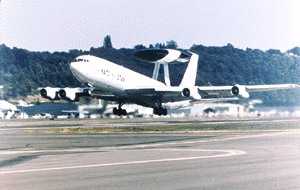Boeing E-3 'Sentry' |

Mission:
The E-3 Sentry is an airborne warning and control system
(AWACS) aircraft that provides all-weather surveillance,
command, control and communications needed by commanders
of USAF, NATO and other allied air defense forces.
As proven in Operation Allied Force, it isthe premier
air battle command and control aircraft in the
world today.
Features:
The E-3 Sentry is a modified Boeing 707/320 commercial
airframe with a rotating radardome. The dome is 30
feet (9.1 meters) in diameter, six feet (1.8 meters)
thick, and isheld 14 feet (4.2 meters) above the
fuselage by two struts. It contains a radar subsystemthat
permits surveillance from the Earth's surface up
into the stratosphere, over land orwater. The radar
has a range of more than 250 miles (375.5 kilometers)
for low-flyingtargets and farther for aerospace vehicles
flying at medium to high altitudes. The radarcombined
with an identification friend or foe subsystem can
look down to detect, identify and track enemy and
friendly low-flying aircraft by eliminating ground
clutter returns that may confuse other radar systems.
The E-3 fleet completed its largest upgrade
in 2001. Known as the Block 30/35 Modification Program,
the upgrade includes four enhancements: Electronic
Support Measure for passive detection, an electronic
surveillance capability to detect and identify
air and surface-based emitters.
Joint Tactical Information Distribution System to provide
secure, anti-jam communication for information distribution,
position location and identification capabilities.
An increase in the memory capability in the computer
to accommodate JTIDS, EMS and future enhancements.
Global Positioning System , a satellite-based positioning
capability to provide precise global navigation.
Other major subsystems in the E-3 are navigation, communications and computers (dataprocessing). Consoles display computer-processed data in graphic and tabular format onvideo screens. Console operators perform surveillance, identification, weapons control,battle management and communications functions. The radar and computer subsystems on the E-3 Sentry can gather and present broad and detailed battlefield information. Data is collected as events occur. This includes position and tracking information on enemy aircraft and vessels. In time of crisis, this data can be forwarded to the president and secretary of defense in the United States.
In support of air-to-ground operations, the Sentry can provide direct information needed for interdiction, reconnaissance, airlift and close-air support for friendly groundforces. It can also provide information for commanders of air operations to gain andmaintain control of the air battle. As an air defense system, E-3s can detect, identify and track airborne enemy forces far from the boundaries of the United States or NATO countries. It can direct fighter-interceptor aircraft to these enemy targets.
Experience has proven that the E-3 Sentry can respond quickly and effectively to a crisis and support worldwide military deployment operations. It is a jam-resistant system that has performed missions while experiencing heavy electronic countermeasures. With its mobility as an airborne warning and control system, the Sentry has an greater chance of surviving in warfare than a fixed, ground-based radar system. Among other things, the flight path can quickly be changed according to mission and survival requirements. The E-3 can fly a mission profile for more than 8 hours without refueling.Its range and on-station time can be increased through inflight refueling and the use ofan on-board crew rest area. The aircraft are used as a surveillance asset in support of counter drug missions. U.S.Customs Service officers may fly aboard the E-3 Sentry on precoordinated missions todetect smuggling activities.
Background:
Engineering, test and evaluation began on the first
E-3 Sentry in October 1975. In March 1977 the 552nd
Airborne Warning and Control Wing (now 552nd Air
Control Wing, Tinker Air Force Base , Okla.), received
the first E-3s. Air Combat Command has 28 E-3s
at Tinker, two at Elmendorf AFB , Alaska, and one
at Kadena AB , Japan. Pacific Air Forces has four
E-3 Sentries assigned to the 961st Airborne Air
Control Squadron (AACS), Kadena AB and the 962nd
AACS, Elmendorf. The first E-3 was delivered
to NATO in January 1982. The United Kingdom has
seven E-3s, France has four, and Saudi Arabia has five.
Japan has four 767 AWACS.
E-3 Sentry aircraft were among the first to deploy
during Operation Desert Shield wherethey immediately
established an around-the-clock radar screen to defend
against Iraqiaggression. During Desert Storm, E-3s
flew more than 400 missions and logged more than5,000
hours of on-station time. They provided radar surveillance
and control to more than120,000 coalition sorties.
In addition to providing senior leadership with time-criticalinformation
on the actions of enemy forces, E-3 controllers assisted
in 38 of the 40air-to-air kills recorded during the
conflict. The data collection capability of the E-3
radar and computer subsystems allowed anentire air
war to be recorded for the first time in the history
of aerial warfare.
In March 1996, the Air Force activated the 513th Air Control Group, an AWACS ReserveAssociate Program unit, which performs duties on active-duty aircraft. During the spring of 1999, the first AWACS aircraft went through the Radar SystemImprovement Program. RSIP is a joint U.S./NATO development program that involves a majorhardware and software-intensive modification to the existing radar system. Installation of RSIP will enhance the operational capability of the E-3 radar electronic counter-measures,and dramatically improve the system's reliability, maintainability and availability. U.S.installation is RSIP is scheduled for completion in fiscal 2004.
 |
 |
Characteristics
Primary
Function: Airborne surveillance, command, control
and communications
Power
Plant: Four Pratt & Whitney TF33-PW-100A turbofan
engines
Thrust:
21,000 pounds (9,450 kilograms) each engine
Dimensions
(L x W x H): 44 x 39.7 x 12.5m
Rotodome:
30 feet in diameter (9.1 meters), 6 feet thick (1.8
meters),mounted 11 feet (3.33 meters) above fuselage
Speed:
Optimum cruise 360 mph (Mach 0.48)
Ceiling:
Above 8,788 meters
Maximum
Takeoff Weight: 156,150 kilograms
Endurance:
More than 8 hours (unrefueled)
Crew:
Flight crew of 4 plus mission crew of 13-19 specialists
(mission crew size varies according to mission)
Date
Deployed: March 1977
|
|
|
|
|||||